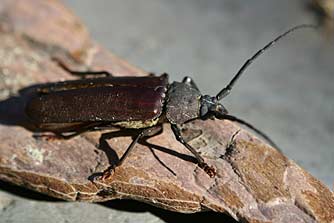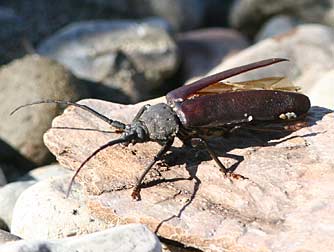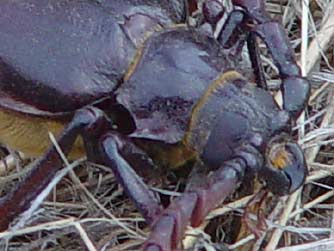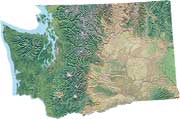
Ponderous borer beetle or Ergates spiculatus
The ponderous borer beetle, also called the Western pine sawyer, is a big, red-brown boring beetle whose larva feed on the roots of ponderosa pine, Douglas fir, and other conifers. Ponderous borer larvae, which can measure almost three inches long, tunnel through the sapwood and heartwood of their dead or dying host trees, hastening their decomposition and the fall of dead stands. The sawing jaws of the larvae are said to have inspired the design of the chain saw. Pesticides are ineffective in suppressing its populations, though these beetles might be kept in check by parasitoid wasps where pesticides aren't used.
Ponderous borer adults emerge from midsummer into fall and move about nocturnally, drawn to light, which may disperse them on full-moon nights. Among the largest of the long-horned beetles, Ergates adults may be over 2 inches long with grubs growing around 3 inches long. Ergates spiculuatus range from California to British Columbia and east into the great basin states and Eastern Washington.
These beetles have dull reddish-brown wing covers and black head and thorax, have fine teeth along the pronotum, and long antennae comprised of cylindrical segments on both males and females. A similar resident beetle, the California prionus beetle, has larva that feed on the roots of living trees and shrubs and is distinguished by large spines on its pronotum and conical antennae segments on the males.

Ponderous borer or Western pine sawyer
after crawling from a lake after a moonlit night

Ponderous beetle - Ergates spiculatus
distinguished by fine teeth along pronotum and cylindrical antennae

Compare to California prionus beetle - Prionus californicus
distinguished by large teeth along pronotum and conical antennae of males


